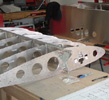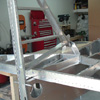


random user submitted photo
Two CHT, two EGT - which to monitor
13 posts
• Page 1 of 2 • 1, 2
Two CHT, two EGT - which to monitor
All,
My AlphaMFD can monitor two of each using type Ks. Should I monitor the rear two cylinders?
My AlphaMFD can monitor two of each using type Ks. Should I monitor the rear two cylinders?
Bryan Cotton
Poplar Grove, IL C77
Waiex 191 N191YX
Taildragger, Aerovee, acro ailerons
dual sticks with sport trainer controls
Prebuilt spars and machined angle kit
Year 2 flying and approaching 200 hours December 23
Poplar Grove, IL C77
Waiex 191 N191YX
Taildragger, Aerovee, acro ailerons
dual sticks with sport trainer controls
Prebuilt spars and machined angle kit
Year 2 flying and approaching 200 hours December 23
-

Bryan Cotton - Posts: 5492
- Joined: Mon Jul 01, 2013 9:54 pm
- Location: C77
Re: Two CHT, two EGT - which to monitor
If I had to choose, that would be my choice, as they will typically run the hottest.
Mike Smith
Sonex N439M
Scratch built, AeroVee, Dual stick, Tail dragger
http://www.mykitlog.com/mikesmith
Sonex N439M
Scratch built, AeroVee, Dual stick, Tail dragger
http://www.mykitlog.com/mikesmith
- mike.smith
- Posts: 1430
- Joined: Tue Jan 29, 2013 8:45 pm
Re: Two CHT, two EGT - which to monitor
Yeah, I'd agree with Mike, certainly for CHT. Although it would be interesting to have a front and back EGT since that's where the big mixture difference is. If you only have EGTs for the back two, you have no idea how pig rich the fronts are running...
- lutorm
- Posts: 259
- Joined: Mon May 15, 2017 1:35 pm
- Location: The Island of Hawai
Re: Two CHT, two EGT - which to monitor
So I bought my exhaust used, and it had 4 EGTs before. How should I seal up the extra holes? I could weld them but it could be fun to move the probes around.
Bryan Cotton
Poplar Grove, IL C77
Waiex 191 N191YX
Taildragger, Aerovee, acro ailerons
dual sticks with sport trainer controls
Prebuilt spars and machined angle kit
Year 2 flying and approaching 200 hours December 23
Poplar Grove, IL C77
Waiex 191 N191YX
Taildragger, Aerovee, acro ailerons
dual sticks with sport trainer controls
Prebuilt spars and machined angle kit
Year 2 flying and approaching 200 hours December 23
-

Bryan Cotton - Posts: 5492
- Joined: Mon Jul 01, 2013 9:54 pm
- Location: C77
Re: Two CHT, two EGT - which to monitor
Could you install 4 probes and incorporate a switch to change between front and back?
- woodmw
- Posts: 24
- Joined: Fri Feb 02, 2018 3:51 am
- Location: KCXO, Conroe, TX
Re: Two CHT, two EGT - which to monitor
my Jabiru exhaust had the egt holes drilled and then filled with stainless steel rivets. Looks like they intended the engine could be run with out EGT's if the owner wished.
Bill Larson
N861SX
Sonex, polished, tail wheel, Generation 4 Jabiru 3300
N861SX
Sonex, polished, tail wheel, Generation 4 Jabiru 3300
- wlarson861
- Posts: 499
- Joined: Wed Dec 05, 2012 11:41 pm
Re: Two CHT, two EGT - which to monitor
Bryan,
The extra holes in my exhaust are filled with CP-42 rivets. No noticeable leakage and then easily drilled out if I want to move the probes around, just to see what the difference is in EGT.
Art,,,,,,,,,,,,,,,,,,,Sonex taildragger #95,,,,,,,,,,,,,,,,,,Jabiru 3300 #261
The extra holes in my exhaust are filled with CP-42 rivets. No noticeable leakage and then easily drilled out if I want to move the probes around, just to see what the difference is in EGT.
Art,,,,,,,,,,,,,,,,,,,Sonex taildragger #95,,,,,,,,,,,,,,,,,,Jabiru 3300 #261
- builderflyer
- Posts: 441
- Joined: Sat Jul 09, 2016 12:13 pm
Re: Two CHT, two EGT - which to monitor
woodmw wrote:Could you install 4 probes and incorporate a switch to change between front and back?
The one issue I see is that the switch is unlikely to be chromel-alumel. This could introduce errors. I suppose you could argue that going from chromel to copper and back should be a net zero voltage. Has anybody done this in practice?
Bryan Cotton
Poplar Grove, IL C77
Waiex 191 N191YX
Taildragger, Aerovee, acro ailerons
dual sticks with sport trainer controls
Prebuilt spars and machined angle kit
Year 2 flying and approaching 200 hours December 23
Poplar Grove, IL C77
Waiex 191 N191YX
Taildragger, Aerovee, acro ailerons
dual sticks with sport trainer controls
Prebuilt spars and machined angle kit
Year 2 flying and approaching 200 hours December 23
-

Bryan Cotton - Posts: 5492
- Joined: Mon Jul 01, 2013 9:54 pm
- Location: C77
Re: Two CHT, two EGT - which to monitor
The problem I see with only monitoring two cylinders is that it's impossible to know which cylinders are the hottest. The coolest running head on my Jab 3300 engine is the rearmost, coincidentally the one that is most often monitored on engines that only have one CHT gauge. In fact, I have a theory, totally unverified, that the reason some Jabiru engines in Australia have had valve failures is because they are monitoring CHT on the wrong head.
Why not just fit another gauge?
Peter
Why not just fit another gauge?
Peter
- peter anson
- Posts: 558
- Joined: Thu Jul 31, 2014 2:34 am
- Location: Mount Macedon, Australia
Re: Two CHT, two EGT - which to monitor
I would recommend monitoring all 4. Aircraft Spruce sell changeover switch's.
On my 2.2 Jab, on the ground the two rear cylinders (cht) are the hottest, this changes over during flight, not by much but it does change.
On my 2.2 Jab, on the ground the two rear cylinders (cht) are the hottest, this changes over during flight, not by much but it does change.
Phil Bird
Sonex 759 JAB 2.2 Tailwheel
Mittagong NSW Australia
http://www.mykitlog.com/corby202/
https://www.flickr.com/photos/78427482@ ... otostream/
Sonex 759 JAB 2.2 Tailwheel
Mittagong NSW Australia
http://www.mykitlog.com/corby202/
https://www.flickr.com/photos/78427482@ ... otostream/
- Corby202
- Posts: 223
- Joined: Mon Dec 30, 2013 2:08 am
13 posts
• Page 1 of 2 • 1, 2
Who is online
Users browsing this forum: No registered users and 50 guests







